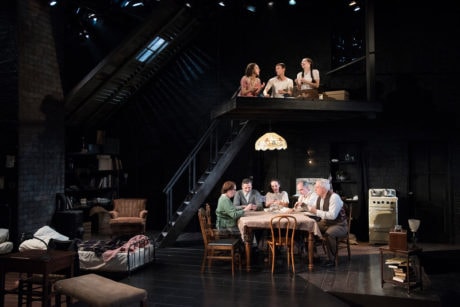Olney Theatre Center is on a roll this autumn. Their production of The Diary of Anne Frank, opening on the heels of their recent success with Angels in America (in a joint production with Round House Theatre), makes Olney a regional leader in tackling issues of social injustice through the arts.

Based on Anne Frank’s classic memoir, The Diary of Anne Frank follows Anne as she comes of age hiding from the Nazi army in an attic in Amsterdam; a harrowing ordeal that has become a story for the ages thanks to her beautifully written diary. Written by Frances Goodrich and Albert Hackett, adapted by Wendy Kesselman and directed by Derek Goldman, this production hits all the right notes in a political season in which the marginalization of specific groups of people is once again up for debate.
Anne Frank’s cast is led by a seasoned ensemble of eight actors portraying the members of the three families offered protection by the brave Miep Gies (Kimberly Schraf). Director Derek Goldman brings these characters to visceral life in performances that highlight the awkwardness and inevitable frustrations of living in close quarters with relative strangers.

Carolyn Faye Kramer plays Anne with all the frenetic energy of a young girl brimming with life and enthusiasm and makes us feel the high drama of adolescence forced to play out in a claustrophobic attic. At the same time, her nuanced performance captures the qualities that set Anne apart. Kramer’s Anne was a thinker, a feeler, an observer; someone destined for great things if only given the chance to live.
It is Anne’s interactions with many of the other attic inhabitants that brings their characters to life. Anne, as the budding romantic, unsure of the new feelings inspired in her by Peter van Daan (Alex Alferov). Anne as the feisty younger sister who is treated with unflinching tolerance by her serene older sister Margot (Dani Stoller). And Anne as the overly curious roommate to Mr. Dussel the dentist (played with humor and patience by Michael Russotto).
Paul Morella portrays Anne’s beloved father Otto Frank as a man who is a cut above the rest morally and intellectually. He carries a heavy weight and is smart enough to know the stakes at hand for his family. Morella’s final monologue is a raw performance delivered with the strength of a survivor.
Eric Hissom and Susan Rome stand out for their performances of the maritally challenged Mr. and Mrs. Van Daan. Hissom plays Mr. van Daan with frustration constantly simmering under the surface while Rome brings deliciously to life the sometimes exasperating character of Mrs. van Daan, a woman clearly unused to and unsuited to deprivation who clings to her fur coat while stirring up drama at the expense of others.
Brigid Cleary gives a vulnerable performance as Anne’s mother Edith Frank, who must swallow her pride and conceal her worry when Anne pushes her away.
David Burdick’s costumes capture the class with which people dressed in the 1940s, an era in which people carried themselves with elegance in spite of the indignity of stitching an obligatory yellow star on each shirt and when even two years into the ordeal, threadbare clothes were still worn with pride and grace.
Sound Designer Matthew M. Nielson adds a haunting element to the show as echoes of police sirens and SS pronouncements filter into the attic and where the only other source of outside news comes from a radio which plays BBC Radio Europe broadcasts.
Sound and lighting by Zach Blane combine in one crucial final scene, conjuring much in the audience’s imagination, while the lighting throughout the play highlights Anne’s private moments with her diary.
Misha Kachman’s scenic design did a fine job of replicating the cramped attic rooms whose inhabitants were in a constant struggle for personal space. There is the crucial loft space where Anne, Peter, and Margot could sneak off for a few moments away from the adults and the kitchen table which becomes a hub of togetherness in scenes such as the tender Chanukah celebration in which this group attempts to stitch together normalcy out of chaos.

In a recent New York Times Op-Ed highlighted by Olney Theatre Center’s Artistic Director Jason Loewith, writer Nicholas Kristof points out the many reasons why Anne’s story could have ended differently: Her father spoke English, had lived in New York and had friends in the Roosevelt administration whom he begged for visas to allow the family to enter the United States.
And the reasons the Franks were denied refuge here: Most notably an indifferent US populace which turned a blind eye to the plight of millions of Jews and a government that enacted policies based on fear and distrust of refugees that left them with nowhere to go.
Olney Theatre Center’s production of The Diary of Anne Frank forces us to ask ourselves: How much have we changed since then?
Running Time: Two hours and 15 minutes, with a 15-minute intermission.
The Diary of Anne Frank plays through October 23, 2016, at Olney Theatre Center’s Mulitz-Gudelsky Theatre Lab – 2001 Olney-Sandy Spring Road, in Olney, MD. For tickets, call the box office at (301) 924-3400 or purchase them online.
RATING:





